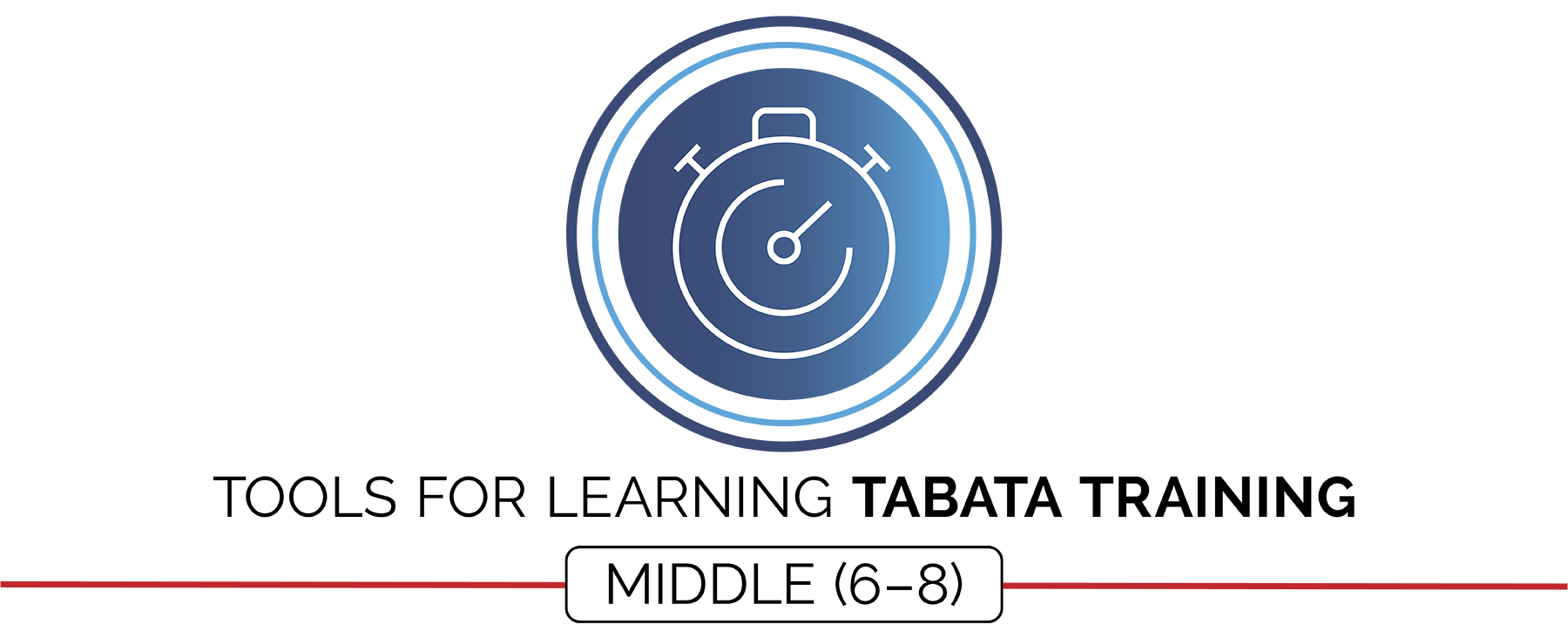Created by: Aaron Hart
Special Contributions: Deedi Brown, Lisa Kushner, Amanda Welch
Design: Aaron Hart & Jennifer Truong
Tabata Training is a short but meaningful module designed to teach the basics of Tabata methodology with a focus on exercise form and fitness knowledge concepts. The two-week module includes an activity and nutrition log in order to bring mindful consideration to each student’s lifestyle choices relating to personal health and fitness.
Planning and implementing this module in the first month of the school year will provide your classes with quick and customizable warm-up options, while also providing students with applicable workout-styles that can be done at home.
Module Documents
Complete Module Packet:
Module Overview:
Required Materials:
All Module Activities:
Sample Lesson Plan:
Academic Language Cards:
Universal Design Adaptations:
All Tabata Routine Cards:
Warm-up Routine Card:
One and Done Routine Cards:
Double or Nothing Routine Cards:
Mirror Mirror Routine Cards:
Flip Flop Don't Stop Routine Cards:
Interval Station Map:
Interval Station Routine Cards:
Activity Plans
Tabata Warm-Up:
One and Done:
Double or Nothing:
Mirror-Mirror:
Flip Flop Don't Stop:
Tabata Interval Stations:
Exercise Videos
- Darebee Exercise Video Library [LINK]
Assessments
Academic Language Quiz:
Holistic Performance Rubric:
Physical Activity Log:
BLANK Warm-up Routine Card:
BLANK One and Done Routine Cards:
BLANK Double or Nothing Routine Cards:
BLANK Mirror Mirror Routine Cards:
BLANK Flip Flop Don't Stop Routine Cards:
BLANK Interval Station Routine Cards:
Muscle- & Bone-Strengthening Exercise Puzzle:
Teacher Evaluation
Teacher Self-Evaluation/Reflection Guide:
Planning Tools
Blank Activity Plan Template:
Blank Lesson Plan Template:
Can’t see the file links? Register for FREE today to access all of the modules. SIGN UP HERE
National Standards and Outcomes Focus for Tabata Training
Standard 3 [M1.6-8] Physical activity knowledge
- Describes how being physically active leads to a healthy body (6);
- Identifies barriers related to maintaining a physically active lifestyle and seeks solutions for eliminating those barriers (7);
- Identifies the 5 components of health-related fitness and explains the connections between fitness and overall physical and mental health (8).
Standard 3 [M6.6-8] Fitness knowledge
- Participates in moderate to vigorous aerobic physical activity that includes intermittent or continuous aerobic physical activity of both moderate and vigorous intensity for at least 60 minutes per day (6);
- Participates in moderate to vigorous muscle- and bone-strengthening physical activity at least three times a week (7);
- Participates in moderate to vigorous aerobic and/or muscle- and bone-strengthening physical activity for at least 60 minutes per day at least 5 times per week (8).
Standard 3 [M7.6-8] Fitness knowledge
- Identifies the components of skill- related fitness (6);
- Distinguishes between health-related and skill-related fitness (7);
- Compares and contrasts health-related fitness components (8).
Standard 3 [M14.6-8] Fitness knowledge
- Identifies major muscles used in selected physical activities (6);
- Describes how muscles pull on bones to create movement in pairs by relaxing and contracting (7);
- Explains how body systems interact with one another (e.g., blood transports nutrients from the digestive system, oxygen from the respiratory system) during physical activity (8).
Standard 3 [M16.6-8] Assessment & program planning
- Maintains a physical activity log for at least two weeks and reflects on activity levels as documented in the log (6);
- Maintains a physical activity and nutrition log for at least two weeks and reflects on activity levels and nutrition as documented in the log (7);
- Designs and implements a program to improve levels of health-related fitness and nutrition (8).
Standard 4 [M7.6-8] Safety
- Uses physical activity (PA) and fitness equipment appropriately and safely, with the teacher’s guidance (6);
- Independently uses PA and exercise equipment appropriately and safely (7);
- Independently uses PA and fitness equipment appropriately, and identifies specific safety concerns associated with the activity (8).
Standard 5 [M1.6-8] Health
- Describes how being physically active leads to a healthy body (6);
- Identifies different types of physical activities and describes how each exerts a positive impact on health (7);
- Identifies the five components of health-related fitness (muscle strength, muscle endurance, flexibility, cardiovascular endurance and body composition) and explains the connections between fitness and overall physical and mental health (8).

